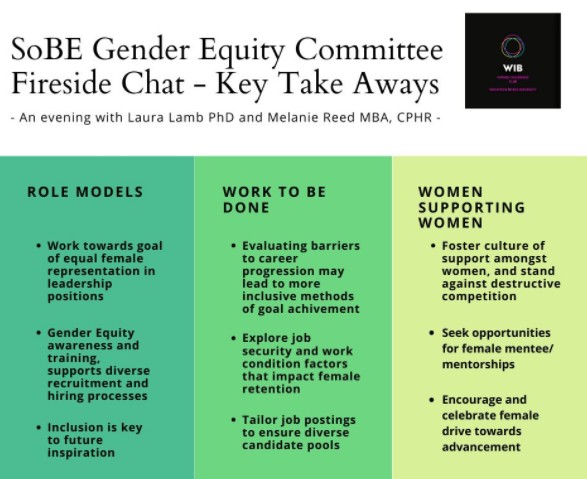What is the value of gender equity? A 2015 report by Mckinsey Global Institute found if every country matched the progress toward gender parity of its fastest-improving neighbour, global gross domestic product could increase by up to $12 trillion in 2025. But with women in Canada still earning 13 percent less per hour, on average, than their male counterparts, we have a long way to go. Let’s look at a few things we can all do to help close that gap.
Move beyond stereotypes

Master of Business Administration (MBA) students Gina Dillon and Jennifer Lopez were inspired to start the TRU Women in Business Club after learning in their human resources (HR) courses about barriers women face in attaining leadership roles. They launched a Fireside Chat series to bring in women leaders to talk more about these issues and expose students to role models.
“The idea behind the club was to create a space where students can gather to talk about, what are the barriers that women face especially in leadership in the business world and how can we overcome those and, in a broader sense, create a support system around a network of people that can carry on past graduation,” says Dillon.
“As we start to see more women in those leadership roles, you start to be able to vision yourself there as well,” Lopez adds.
Dr. Scott Rankin, a School of Business and Economics faculty member who formerly worked in the oil and gas industry, teaches the HR courses that inspired Dillon and Lopez. One of the topics his classes discuss is how traditional women’s and men’s roles are perceived and valued by society.

“How would you compare the value of a nurse versus a firefighter?” he asks. “Who is exposed to more danger?”
Based on stereotypes, you might say firefighter. Yet nursing is also one of the most dangerous jobs in the world. However, the former conjures dramatic images of someone saving a child from a burning building while the latter conjures images of a smiling caregiver.
If we have to see to believe, it’s important roles are portrayed realistically and women gain exposure to more leaders in nontraditional roles.
Encourage diverse job candidates
Recently, the Women in Business Club welcomed Dr. Laura Lamb and Melanie Reed, both School of Business faculty members, to talk about their work on the faculty’s Gender Equity Committee. One of the key takeaways was the need to re-evaluate job advertisements to be more realistic. In one study, the top reason women said they didn’t apply for a job was because they didn’t think they met all the qualifications. Reed has four suggestions for improving job ads:
- Review the list of requirements and consider which are unnecessary or can be learned
- Broaden where you advertise to reach more diverse candidates
- Lengthen the time a job is posted for
- Ensure the ad is written using gender neutral language
Support, don’t compete
Dillon recalls management meetings where she was one of two women in a group of about 10.
“When there’s that situation in a workplace, women end up having to compete with each other instead of supporting each other, which isn’t going to help women progress at all,” she says. “Women need to support each other. . . as you move up the ladder, bring women up with you.”
The theme of International Womens Day 2021 is Choose to Challenge. Choosing to challenge our thoughts and our actions about women in leadership and the workforce in general is an essential step in the movement towards gender equity.
Want to learn more?
- Join the Women in Business Club’s Fireside Chat with Yabome Gilpin-Jackson on Wednesday, March 24
- Learn about the experiences and perceptions of women in management in “The Mexican Glass Ceiling and the Construction of Equal Opportunities: Narratives of Women Managers” by Salvador Barragan (School of Business and Economics faculty member), Albert Mills and Mary Runte
- Explore gender equity in your country using Mckinsey Global Institute’s Public Tableau dashboards
- Visit www.internationalwomensday.com to learn more about this year’s theme


